|
|
Chapter Four: The Whole Thing Started (1977)

Sydney Haymarket - Jan 31, 1977
The very next day, on Jan 1, 1977, Air Supply performed a free afternoon concert at the Sydney Haymarket as part of the month-long Festival of Sydney. The festival was a real back-to-the-roots and into-the-streets affair - a people’s festival. Throughout January at The Haymarket, Circular Quay and Hyde Park, many of Australia’s top bands performed - Split Enz, Little River Band, TMG, Hush, Ol’55, Windchase, Silver Studs, Rabbit, Matchbox, Dragon, Stylus, Angels, Anne Kirkpatrick Band, Cold Chisel, Ross Ryan Band, City Strut and Jo Jo Zep and the Falcons. The old Haymarket building was a derelict and desolate brick wall and tin roof place, which was transformed into a stage for concerts, areas for drama and crafts, and several stalls selling everything from brass to coffee. The area had been refurbished at a cost of more than $100,000. Despite the improvements, The Haymarket was still considered the most controversial arena of the month-long festival activities.
On January 31, the final day of the festival, Sound Unlimited and Travelodge sponsored a series of concerts on the main stage at the Haymarket. The festival ended as it began, with a rock concert by groups including Air Supply, Dragon, Stylus, Railroad Gin, Taxi and Karma. The show was well attended, and Air Supply was described as one of the fastest up-and-coming bands in the country.

Captain Cook Hotel - Feb 2,5, / Blazers - Feb 4 / Club 25 - Feb 3
When Air Supply appeared on Countdown in December, 1976, they were introduced to Fred Bestall, an American businessman, and Lance Reynolds, a member of an Australian band called the Silver Studs. Bestall and Reynolds had formed an Aussie rock management team in 1975, after a successful relationship as manager and artist. Bestall Reynolds Management signed a management deal with Air Supply in January, and the trio parted company with their existing manager, Doug Henderson, whom Russell described as “kind of an amateur in the business, and more of a friend of the band than a business guy.” Air Supply then changed concert booking agencies, leaving Australia’s leading agency Premier Artists, and joined its competitor Sunshine Entertainment Agency, who also represented the Silver Studs.
The new managers believed that Air Supply was definitely American market material. Bestall and the Silver Studs were heading to America in September where they hoped to check out the scene for Air Supply before any definite overseas plans were made. “There are only so many venues to play in [Australia],” said Bestall. “You can only tour maybe once a year. For a band to stay alive, it must tour three or four times a year. But that just waters the success down. Any management has to look at the international market and plan accordingly, rather than planning to first have huge success in Australia and then look at the international market. Otherwise, you’ll have a dead act in six months.”
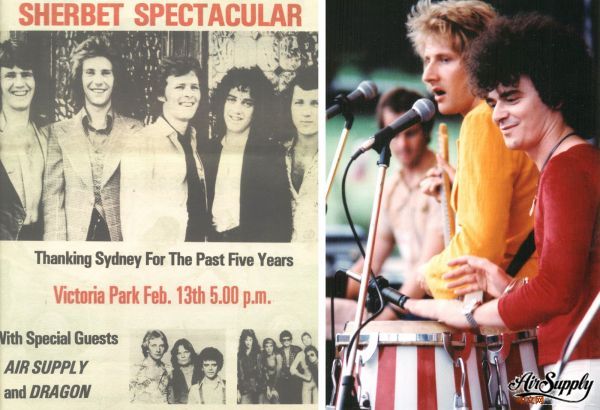
On February 13, Air Supply, Dragon and headliner Sherbet performed at a free outdoor concert in Sydney’s Victoria Park. The afternoon event was sponsored by 2SM Radio and attracted a crowd of 40,000. Radio stage promotion provided a major level of exposure for Australian pop/rock talent. 2SM (Sydney), 3XY (Melbourne) and 4IP (Brisbane) presented large outdoor shows at least three times a year, and attendance had been as high as 80,000. The exposure value of these shows for emerging acts was quite inestimable.
On February 20, Air Supply shared top billing with local singer-songwriter Doug Ashdown at the 2,000-seat Dallas Brooks Hall in East Melbourne, the largest venue they had headlined at to date. The concert, Air Supply’s first in Melbourne, was part of the Sunday Night At The Dallas series, a popular event with Melbourne audiences. Ashdown was touring on the strength of his single ‘Winter In America,’ which charted in Australia for 28 weeks. Also on the bill was Australian singer Marty Rose, who years later formed the first electronic duo with Air Supply keyboardist Adrian Scott. Air Supply was the final act of the evening and they had the crowd begging for more, most of whom had never seen them live. For one of the slower songs, ‘It’s Not Easy,’ Air Supply performed behind a young female ballet dancer. The concert got rave reviews in the local press:

Dallas Brooks Hall - Feb. 20, 1977
Air Supply proved that they are not only a charming bunch of guys, but on stage a very polished, and professional act that left the crowd of people of all ages chanting for more. Marty Rose warmed the show up, followed by Doug Ashdown, who ended with a superb rendition of ‘Winter In America,’ his current single. Amid gentle clouds of white smoke, Air Supply took the stage. Dressed in brilliant white, the three impressed all with their beautiful harmonies, but it was the soaring range of the dark haired Russell Hitchcock’s voice that really stood out. Playing guitarist Graham Russell’s original material from the album, Air Supply left no doubt that Australia will be hearing plenty from them this year. - Spunky! Magazine
The touring band for Air Supply included Mark McEntee, Adrian Scott and drummer Nigel Macara. Macara was already an established musician in the Oz rock scene, having played in several Australian bands, including Tamam Shud, Stonehenge, Sailing and Ariel. He left Ariel in October 1976, after he and lead singer Michael Rudd had a personality clash, Macara being an introvert and Rudd the extreme opposite. Before joining Air Supply in January, Macara had performed with Jon English and Trevor White. Graham had admired Macara’s playing for about six years and asked him to join Air Supply when he knew he was available. Despite having been a member of Ariel, which seemed like an impossible transition to Air Supply, Macara jumped at the opportunity. It was a chance for him to be more flexible and have more room to move within musical boundaries.
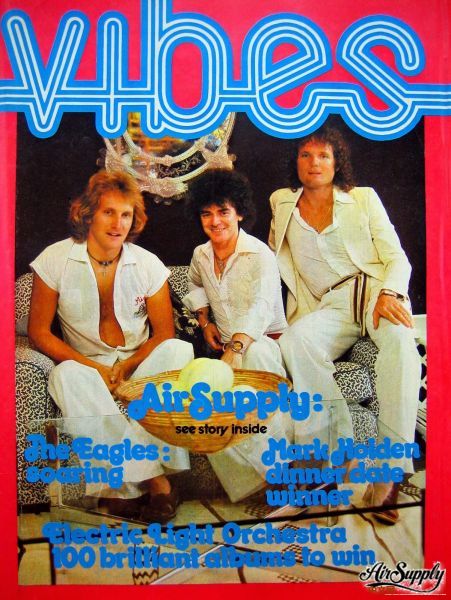
Air Supply had, due to lack of other suitable venues, been playing mostly discos in Canberra and Adelaide, but insisted they were not a disco band. In Sydney, Brisbane and Melbourne they performed at clubs where disco music played before the main act took the stage. “We don’t play disco music and we never will,” said Graham. “We’re not as big in Adelaide as in Melbourne or in Sydney, which is strange because Adelaide broke the single. Perhaps it’s because the recorded disco music has such a hold in Adelaide. I don’t know what will happen because I don’t think there is any replacement for live music. It’s on the turn in America, and it’s already starting to die out in Sydney. Personally the disco thing just drives me stupid. I can’t handle it. I was thinking the other night of wearing headphones while I was waiting for the disco music to finish, because I can’t bear it, but anyway that’s a personal thing.”
Disco forced many Australian bands to adapt to the changing landscape. Some rock and roll bands, such as Sydney’s Rabbit, chose to break up. Rabbit lead singer, Dave Evans, believed that disco was a major factor in the bands demise. “It was the disco’s,” he said. “It was basically an economic problem because we just couldn’t make any money. Jobs were so few and far in between, and we were rushing all around the country. The disco thing has really taken off here; even balladeers like the Bee Gees have gone into the disco thing. Almost every venue in Sydney has brought in a disco, and there is less and less chance of live bands finding work. It hasn’t just affected us - even bands like Ariel and Hush were having similar sort of problems.”
Air Supply’s live show was understated compared to what was popular in Australian music at that time. There were no crazy stage antics. Each member performed within the guidelines of their role, and there were few individual solos. They were very civilized and polite; giving the impression that they’d rather die than goof off on stage. Russell still got extremely nervous before each show. His knees shook uncontrollably and his knuckles turned white from holding the microphone too tight. Russell’s bongo drums, painted as an American flag, provided a small measure of separation between himself and the audience, which helped ease his nerves. “We always wanted to keep the band on a level that was different to anything else in Australia,” said Russell. “We wanted to have a classy image, to look good. And we wanted the product to sound good. We feel we have a responsibility to play live, something that’s really good and as good as the album. We started at the top of the ladder with a hit and we’re working really hard to keep it as good as we can. At the moment it can only get better - we don’t aim to slide down one rung of that ladder.”
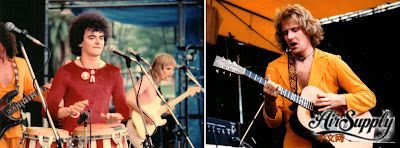
2SM Victoria Park, Sydney - Feb 13, 1977
Air Supply had only been performing together for a few months, but they were all very capable musicians. Russell’s unusually high and clear vocal range was not well-suited for Aussie rock, but he could sing loudly. His voice had already brought him several singing sessions in various studios with established Australian acts. Jeremy Paul, who played a Fender Precision bass with acoustic amplifier and JBL speakers, was an experienced baritone, having taken singing lessons for things other than rock. His interest in musical theatre led him into musical comedy. Then came Joseph and the Amazing Technicolor Dreamcoat, and the acceptance for Sgt. Pepper’s Lonely Hearts Club Band stage show, which he turned down to join Superstar. Graham, who mostly played rhythm with a pick and little fingering, used a Fender Telecaster and a custom-made acoustic guitar by Chris Finch in Melbourne. Because he played with not only the body but also the strings upside down, he lost a bit of bottom end hitting the treble strings first. To counter this he used the bass pick-up a lot and had the tone controls low down. Nigel Macara was already considered one of Australia’s best drummers. He was well versed in a wide variety of music, including acid-rock, progressive rock, beat pop, blues and jazz. Adrian Scott was a talented arranger and keyboardist, using a variety of instruments including an 86 Fender Rhodes and an ARP synthesizer for strings and brass. Mark McEntee, a deeply eccentric individual, was a trained jazz guitarist who’s style suited Air Supply quite well. He created terrific melody lines. “Mark had his own style,” said Australian television producer Vince Lovegrove, “subtle and under-played, with that rhythmic chop which is quite rare in lead guitarists, who usually like to demonstrate their proficiency at playing different notes at speed. Mark’s playing reminded me of Keith Richards and Malcolm Young who are the two best rock rhythm guitarists in the world, and of the magical rhythms of Bob Diddley and Chuck Berry.”
The Australian pub circuit was not quite sure what to make of Air Supply’s polished live performance. Annie Burton of RAM magazine described a typical reaction; “A friend of mine went to the Bondi Lifesaver one night in search of some hard rock to lighten her lethargy. After a time, she expressed the opinion that the resident disc jockey must be losing his grip on variety. ‘This record’s been playing for half an hour’ she said, gazing distractedly towards the back of the room. Somebody pointed her head in the direction of the stage, and sure enough, there was a real live band playing. It was Air Supply. Whatever conclusion you draw from this modest tale depends on your attitude towards this careful trio. You could be of the opinion that Air Supply’s live performance is so polished that it could be mistaken for the recorded product, as indeed it is. On the other hand, especially if bobbing is what tickles your rocks, you could conclude that their actual stand and deliver presence is about as charismatic as watching that record revolve. Whatever, the lady in question dozed off against the bar soon after... Ah, but there’s lots that don’t. Doze off, I mean.”
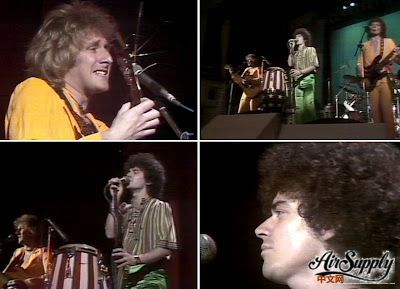
Myer Music Bowl, Melbourne - Feb 14, 1977
In January, Air Supply learned that they would be the opening act for Rod Stewart on his first solo tour of Australia, excluding Perth. Support spot for Stewart was not a position that most Australian bands could just walk into. It was considered a coup of sorts when it was announced that Air Supply had won the gig. Stewart was having a terrific couple of years with several Top 40 hits, and was among the music industries most successful solo acts. His manager Billy Gaff, a short, mildly spoken Irishman with a fast-receding hairline, was good friends with Air Supply’s management team. This relationship was critical in getting Air Supply the highly sought after support spot for Stewart. “We’d been a band for only six months when we got the tour,” said Russell. “So not only was it a very exciting experience for us, it was another world. It was the biggest tour of the year that year. It was like rock and roll at its peak!”
Music critics questioned why Rod Stewart would select a soft rock band like Air Supply to open, but Graham was not at all surprised; “I think Rod wanted that sort of package you know, something mellow. Opening act for any headliner is very important because they can detract from you or add, and I think we added to his show, being fairly low key. After we played in Adelaide, Stewart’s manager was walking around the dressing room singing our songs.”
During his pre-tour publicity, Stewart stressed that his solo tour would be much different than his raw, rough and gutsy tour of Australia with the Faces in 1974. He insisted that everything pertinent to the stage be white, including the grand piano, the speaker boxes, the floor, the leads and the set dressing. “Rock doesn’t have to be denims and dull,” said manager Billy Gaff. “It can be theatrical and exciting. Rod is trying to show that rock can really be made to look a whole lot better.”
The Rod Stewart tour of Australia started on February 7th in Perth, and finished in New Zealand on March 3rd. Air Supply did not perform in Perth and New Zealand.
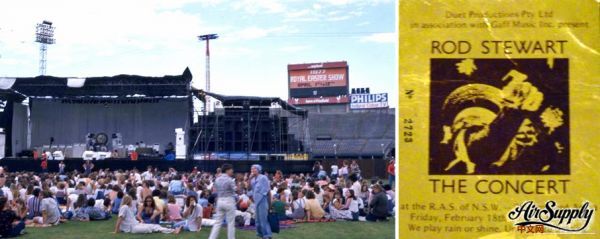
Sydney RAS Showground - Feb 25 Rained Out Ticket
Perth - February 7,8 (Perth Entertainment Centre: Combined Attendance - 16,000)
Adelaide - February 11,12 (Memorial Drive Park: Combined Attendance - 15,600)
Melbourne - February 14,15 (Myer Music Bowl: Combined Attendance - 32,000)
Sydney - February 18,19 (RAS Showground & Hordern Pavilion: Combined Attendance - 38,000. Feb. 18 cancelled due to rain. Rescheduled for Feb. 25)
Brisbane - February 21,22 (Festival Hall: Combined Attendance - 15,000)
Christchurch (NZ) - February 28 (Attendance - 15,300)
Auckland (NZ) - March 3 (Attendance - 33,000)
Rod Stewart’s tour featured one of the most advanced sound systems ever used in Australia. The Jands No. 1 Touring System, valued at $250,000, weighed 28 tonnes and delivered a power output of 24,000 watts RMS. “Certainly a far cry from a column speaker on each side of the stage,” said sound technician Howard Page, “but it’s worth it when I hear members of the audience muttering as they file out, ‘They sound just like their record.’” To accommodate crowds of over 20,000, a sophisticated colour TV was brought in from London to project close-up views of the action onto a massive screen.
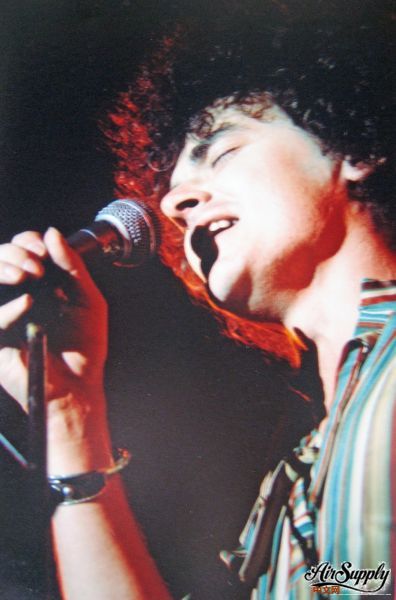
Opening For Rod - Feb 1977 (PIC: Bob King)
Because of Australia’s relatively small population, there were no large American-style indoor arenas in 1977, so promoters were forced to stage concerts in large outdoor venues. The shortcomings of this practice was poor acoustics, and the delay or cancellation of concerts due to rain. Rod Stewart was scheduled to play at the RAS (Royal Agricultural Society) Showground on February 18th, but an unexpected storm forced its cancellation. Just as Air Supply finished their opening set, dark clouds moved in. Then 100 km/h wind gusts blew up, the screens and roof of the stage disappeared, and rain fell onto the electrical equipment. Stewart was just minutes from walking onto the stage when concert organizers were forced to stop the show. After an hour delay, the light rain turned into a deluge, sending fans scampering for shelter in the stands behind the stage. While thunder rumbled overhead, they chanted: “We want Rod!” Much to the dismay of the fans, concert promoters announced that the show was postponed. This despite the ‘we play rain or shine’ on the $9 ticket. The disappointed, rain-soaked fans booed the news while leaving the Showground. Many fans who had discarded their ticket stubs before the cancellation angrily confronted Showground attendants afterwards, demanding to know how they would get into the postponed concert.
Despite the difficulties created from the washed out concert at the Sydney Showground, concert promoters Duet Productions and Billy Gaff were more than pleased with the number of tickets sold in Australia and New Zealand. The re-scheduled February 25th show at the RAS Showground in Sydney set a new single event attendance record of 32,000. It is estimated that Stewart’s promoters grossed over $240,000 from this concert alone. The tour of Australia was considered such a financial success that, while in Brisbane, Stewart purchased a $93,000 Lamborghini and had it delivered to his home in California. The Australian portion of Stewart’s The Concert tour was the highest grossing Australian tour to date. Similarly, the combined crowd of 48,300 at the Christchurch and Auckland concerts represented 1% of the entire population of New Zealand.
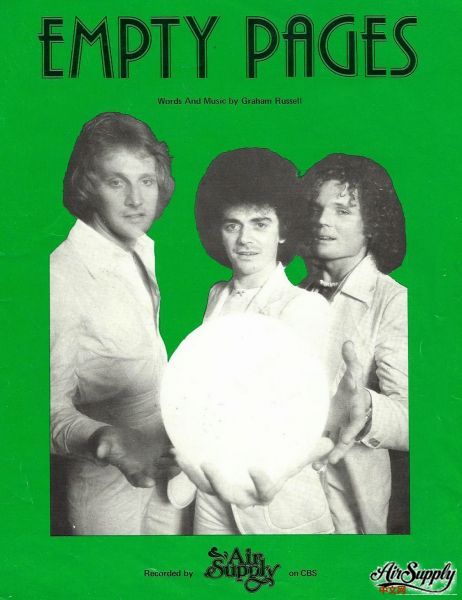
CBS negotiated to have ‘Love And Other Bruises’ released in the U.K., but not before they entertained the idea of allowing Paper Lace, a British band from Nottingham, to do a cover version for the English market. This did not sit well with Air Supply. The song was undoubtedly good enough to make it on its own merits. CBS relented and released Air Supply’s version in the U.K., Canada and New Zealand in April, 1977, with the album to follow if the single sold well. But ‘Love And Other Bruises’ failed to impress British radio, and Air Supply’s first foray into the U.K. disappointed. The album was later released in Canada and New Zealand, but not the U.K. CBS had entered into negotiations to have the single and album released in the U.S., but interest waned after ‘Love And Other Bruises’ flopped in the U.K. and Canada.
Air Supply released their second single, ‘Empty Pages,’ and it first charted on February 7 in Adelaide. A couple weeks later it got airplay in the state of Victoria, and was hit-picked in all the other states. ‘Empty Pages’ did not have the success that ‘Love And Other Bruises’ did, but it reached #43 on the Kent Music Report and charted for 15 weeks. It reached #12 on 4IP Top 40 in Brisbane. Television show Countdown had Air Supply perform ‘Empty Pages’, and later aired a short excerpt of this performance on Countdown’s 100th episode celebration on April 3, 1977.
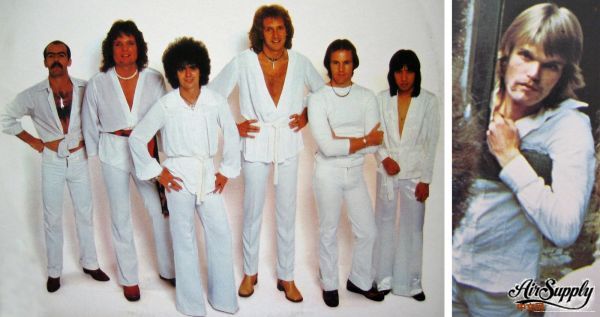
(L-R) Macara, Paul, Hitchcock, Russell, Scott, Goh. Mark McEntee
Mark McEntee left Air Supply following the February concert at the Dallas Brooks Hall. He was not happy with his role in the band, as simply a hired backing musician, and he was not keen on the direction of the bands music. McEntee was replaced by Melbourne guitarist Brenton White. White was married to Lyndsay Hammond, and had helped write the music for ‘Love and Other Bruises’ a few years earlier.
“I used to work as a guitar player, playing on a lot of sessions,” said Mark McEntee. “I did this to make a living. When I was doing that I was introduced to Air Supply by producer Peter Dawkins. Peter was working with CBS Records at the time, and they got to know me when I was a really young guitar player after I moved to Sydney. Peter used to call me in for session work, so he called me when he was working with Air Supply. I worked on their first album, which had a big hit in Australia called ‘Love and Other Bruises.’ After that album they changed direction and became known for doing love songs. But that first album was a really interesting record for the time. It was really different. I left Air Supply after that first record because I wasn’t really part of the song writing team. It just wasn’t my thing. I worked with them because I was a session player, and I played on lots of peoples records.”

'Empty Pages' Promotional Video
On March 9, The 7 Network aired a 90-minute special of Rod Stewart’s concerts at the Myer Music Bowl. Hoping to boost their ratings, HSV-7 aired the special within three weeks of the actual concerts, a relatively short period for a special of this type. Local band Air Supply was featured at the half-way mark of the broadcast, performing their nationwide hit ‘Love And Other Bruises.’ The use of six cameras and a 26-track audio mixer guaranteed that the visual and sound performance was as good as television amplifiers would allow. The broadcast was a major publicity boost for Air Supply.
Some of Air Supply’s live performances were featured on Nightmoves, a new 90-minute late-night music television show that catered to an ‘alternative’ rock audience. The Melbourne based Nightmoves was hosted by XY disc jockey, Lee Simon, and focused mostly on older footage from Dan Kirshner’s American Rock Concert series. The show was careful not to ignore Australian bands, and was “put together according to the feel of what is happening around town, both with album releases and touring bands.”
On March 28, Air Supply started recording a follow-up album to their successful debut LP, with Peter Dawkins returning as producer. The recording took place at Albert Studio, where ‘Love And Other Bruises’ and ‘If You Knew Me’ were recorded six months earlier. The new album was to be in the same musical style to the debut album, but a few of the songs were expected to surprise some people. Rex Goh, a guitarist from Singapore, replaced Brenton White before the start of the Albert recording sessions. Goh moved to Adelaide in 1972, where he joined a Yes cover band. They developed quite a following, and had a residency at the Hotel Tivoli each Tuesday night. He moved to Sydney in 1976, and later auditioned as lead guitarist with Air Supply.

Gold Album Presentation (Sydney) - April, 1977
In April, Air Supply’s debut album was awarded gold for Australian sales in excess of 20,000. William Smith, the managing director of CBS Australia, presented the award at a special reception held in Sydney. This was quite an accomplishment, but Graham had much greater ambitions; “A hit in Australia means nothing. We’ve all been in the business long enough to know that there’s more to success than one hit single. The task is ahead of us to prove we’re not just one-hit wonders. There is a lot of hula-la about Australian bands at the moment because they are selling platinum and double platinum albums, but when you boil it down, they are still only selling about a hundred or a hundred and fifty thousand albums. And they consider themselves superstars. It’s like a company. With good management and careful planning there’s money to be made, but new bands have to be content with what they get. The overheads are so high we’re just breaking even.”
In Australia, 20,000 albums and 50,000 singles are required for gold, and 50,000 albums and 100,000 singles for platinum. This is a far cry from the U.S. where 500,000 albums is required for gold and 1 million for platinum. At the 1977 Australian TV Week King Of Pop Awards, Peter Dawkins won the Producer Of The Year award for his work on Air Supply’s debut LP.

Air Supply got an opportunity to go international when Rod Stewart invited them on his tour of North America, which was slated to start in September. Stewart picked Air Supply as his personal choice after travelling with them in Australia, and insisted that they be billed as his ‘Special Guests.’ Air Supply’s managers, Bestall and Reynolds, were instrumental in facilitating the North American tour, having paid a reported $10,000 to secure the support slot. Increasingly, headliners in Australia and America insisted that opening acts pay, a trend that drew criticism from some. Sherbet angered many top Australian groups and artists when they put the support spot on their tour up for grabs. The record company for the eventual winners, Redhouse, paid $10,000. Roger Davies of Sherbet argued that on previous tours, Ted Mulry Gang and John Paul Young did better supporting Sherbet than Sherbet did themselves, because accommodation and transport costs are so high.
“Our management at the time were good friends with his manager Billy Gaff,” said Russell. “I don’t remember what happened, but we got to open for him in Australia in all the major cities. After the second show, Rod came to us and said, ‘Do you guys want to open for me in North America?’ We had a conversation with one of the record people with CBS and this guy said, ‘No, it’s too soon.’ So we told him that we have to for it. He responded by saying, ‘No, what you should do is stay in Australia and we will make you bigger than Sherbet.” Graham added, “But we were a few months old and already the biggest band in Australia. Where else could we go? Nowhere but down. We were like a racehorse ready to bolt. We knew something was happening but didn’t know what it was. But we did know that ‘Love And Other Bruises’ was just the beginning.” So, against the wishes of their Australian label, Air Supply began preparations for the trip to America.
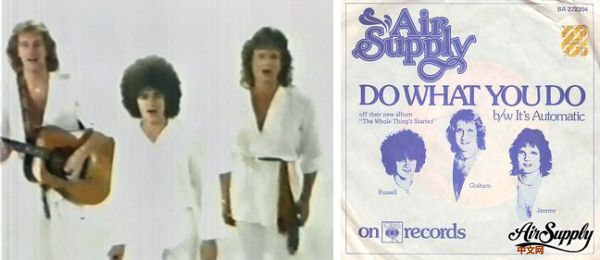
‘Do What You Do’ Music Video & 7" Single - 1977
Air Supply’s second album, ‘The Whole Thing’s Started,’ hit Australian record stores on June 27, 1977. The lead single, ‘Do What You Do,’ was released on May 30 and reached #45 on the Kent Music Report, but failed to crack the all-important Top 40. It had better success on local charts, where it got into the Top 20. The single was promoted quite heavily, including a promotional music video played on television shows Countdown, Sounds Unlimited and Nightmoves. People rushed out to buy ‘Do What You Do’ after hearing that Air Supply had been chosen to support Rod Stewart overseas. But promotion and radio play did not translate into album sales, as is common with sophomore albums, and ‘The Whole Thing’s Started’ sold below expectations. This despite an aggressive marketing campaign by CBS Australia.‘ The album was released in Japan in 1980 with an alternate album cover, then reissued on CD in 1991 and 2002.
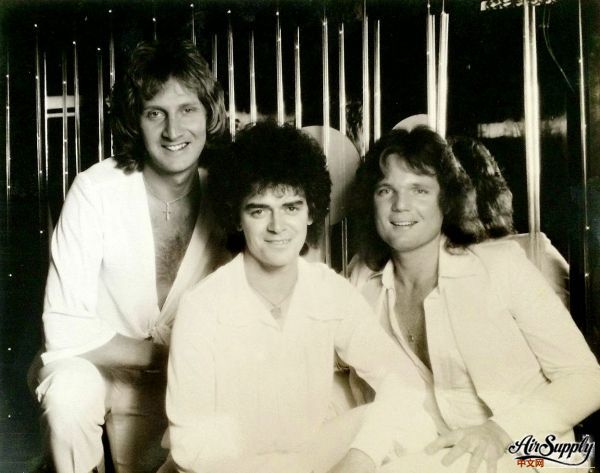
‘The Whole Thing’s Started’ Press Kit Photo
‘The Whole Thing’s Started’ got mostly positive reviews from Australian music critics:
Air Supply are already in foreign parts, touring Europe and the U.S. But before they departed they managed to leave us with their second album ‘The Whole Thing’s Started’ (CBS SBP 234999). Graham, Jeremy and Russell got their breaks in the cast of Jesus Christ Superstar, and dominant musical chorus on the first track (‘Teach Me To Run’) of the new album is straight out of the shows title number. But ‘Teach Me To Run’ also sets the trend for the album with strong vocal harmonies and powerful melodic backings. The single off the album, ‘Do What You Do,’ is a pleasant medium-paced number but I think they might also have done well with the rocky ‘The End Of The Line.’ Like many follow up albums this one is very well put together, with strong material and great production, but there is no hit single in the class of ‘Love And Other Bruises.’ Best number on the album is ‘Love Comes To Me,’ which is a classic example of how to build a song with crescendo, excellent vocal lead and harmony. - The Age

'The Whole Thing's Started' - June 1977
Leading up to the launch of ‘The Whole Thing’s Started,’ Air Supply spent several hectic weeks touring Queensland to help promote the album. The culmination of that tour was a double-billed show with Skyhooks at Brisbane’s Botanical Gardens on June 26. Two days prior, Air Supply had played two sold out shows at Toowoomba’s Town Hall, before rushing to Brisbane at 6 a.m. for a full day of television promotion and the following day’s gig with Skyhooks.
The concert with the Skyhooks at the Brisbane Botanical Gardens was a sun-drenched circus, and was completely packed with fans. It was a free concert sponsored by Brisbane’s top AM radio station 41P. Ross Gardiner of RAM magazine was at the concert and wrote the following review:
Having watched Air Supply perform in Toowoomba and Brisbane it is easy to see why this band is confident of making the big time in the States. The band’s image of three front men, impeccably robed in all-white, the vocals and harmonies draining every ounce of emotion from Graham Russell’s tear-jerking lover’s laments, is broad enough to strike a chord with everybody from love-sick fourteen year old females to ailing grannies with an ear for an easy melody. It ain’t rock and roll, but no one ever claimed it was.

Air Supply put on a well thought out and relatively tight, if unexciting, show. Their opening numbers, ‘Teach Me To Run’ and ‘What A Life’ are bouncy and up, loaded with the sugar-sweet melodic harmonies, and the crowd respond accordingly. The audiences I saw them perform before seem pleasantly surprised by the on-stage dexterity of the band. In comparison to their stone-faced Countdown appearance and the waves-crashing-on-the-cliffs melodrama of their film clips, Air Supply attain a level of integrity that is due, quite significantly, to the abilities of the band’s back line.
Rex Goh, a native of Singapore, plays some very mellow lead guitar that soars but never growls. Nigel Macara does nothing to tarnish his reputation as one of Australia’s top drummers as he keeps the rhythm happening with ease. Adrian Scott, on assorted keyboards, plays his parts efficiently, though unspectacularly. ‘Love And Other Bruises,’ ‘Feel The Breeze’ and ‘Empty Pages’ all go down very well, but the biggest surprise is their new single, ‘Do What You Do.’ Whilst not as strong as ‘Love And Other Bruises’ the newie gets the best reaction in the hour-long set. Ironically it will not be included on the American album. - Ross Gardiner, RAM
On Saturday July 2, just three days before Air Supply was to depart for the States, they performed a 75-minute farewell concert for 1,000 fans at the historic Elizabethan Theatre in Sydney. A Sydney-based concert reviewer wrote the following for Variety magazine:
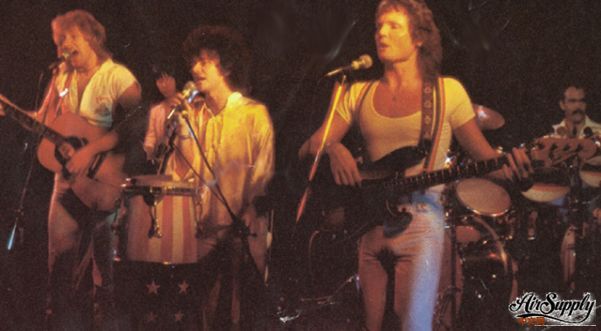
Promoting 'The Whole Thing's Started' in Australia
It took the soft rockers four numbers to spark the lukewarm audience. At times their playing lacked the cohesion of a tight group, but there were cheers after ‘Love And Other Bruises’ (their first big hit) and enthusiasm waxed as they rolled out pieces like ‘Ready For You’ and ‘It’s Automatic’ which had hands clapping to the beat. Vocalist Russell Hitchcock has a strong versatile voice and with all material from guitarist/vocalist Graham Russell’s pen, the act has an individual flavour that compensates for some occasional loose playing. - Variety
As part of the Rod Stewart tour deal, Billy Gaff arranged for Air Supply to sign a record contract with Columbia Records in America. Gaff believed that Air Supply would crack the U.S. market, so he agreed to let them open on the tour, provided his partners, Jimmy Horowitz and Tom Dowd, could produce and mix a new album with them. The deal was struck despite CBS Australia having started on Air Supply’s second album, ‘The Whole Thing’s Started,’ and ongoing negotiations to have Air Supply’s debut Australian LP released in the States. A new album with Columbia would allow Gaff and his entourage to cash in on Air Supply’s enormous U.S. potential, and would almost certainly eliminate the possibility of CBS Australia releasing the first two albums in America. The rhythm tracks and some of the vocals for the Columbia album were to be recorded in Los Angeles over a three week period starting July 4. “[Then] on July 26th we’re going to London for three weeks,” said Graham, “and we play with Boz Scaggs and Chicago at the CBS International Convention. We’re also finishing off the vocals and doing some strings there. Tom Dowd, Rod Stewart’s producer, is mixing the album. We’ve booked Freddy Tackett on rhythm, and the drummer (Jeff Porcaro) from [Boz Scaggs] ‘Silk Degrees’ album. We’re also using Les Dudek and Rod’s touring keyboard player, John Jarvis, on some tracks. Also, we’ve booked a 19-year-old bass player that Tom’s found. Tom says he’s really looking forward to doing the album.”

“The American musicians we use on the album will give the material a slightly different feel,” said Russell. “It’ll be more laid-back and funky. For example ‘Love And Other Bruises’ will be in the same key, but just a bit faster. Different drum patterns.” Upon completion of the album, Air Supply planned on returning to L.A. to promote the record and get some warm up work to get the band used to American audiences.
The relationship between Air Supply and CBS Australia deteriorated quite rapidly. Shortly after ‘Love And Other Bruises’ charted, Air Supply became disillusioned with their record label. “Almost at once we started to get negative feedback from around the country that the band was very unhappy, first with the company, and then with me,” said Peter Dawkins in his book titled The Icecream Boy. “Finally the band played with Rod Stewart [in Australia], courtesy of my contacts within CBS, and Stewart’s management smelled money. Air Supply was offered a tour with Rod Stewart in the U.S. and Canada, which had great appeal to CBS in New York. They contacted me for endorsement, which I excitedly gave, as the prospect of an extensive tour with a major artist looked great from everyone’s perspective. And then my world fell apart. I had a call from Dick Asher, the President of CBS, who apologized to me but... It turned out that Stewart’s manager, Billy Gaff, had approached CBS to support the tour, but only if his partner, Jimmy Horowitz, could produce an album with Air Supply. It was without doubt the only decision that CBS could make. It seemed that the album I had produced was suddenly not suitable for American consumption. This, even though it was already released and successful in four countries, including Canada.”
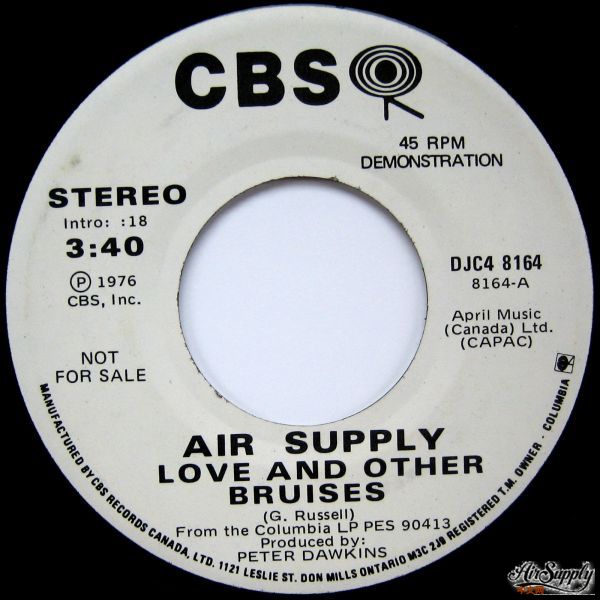
1977 Promo Single - Canada
Much careful planning went into preparing the American album before the trio left for the States. When Jimmy Horowitz came to Australia to lay the groundwork for the album, he wanted at least eight singles on it to choose from. He used a stop watch and went through the songs to ensure that each one had a hook within 25 seconds. If not, the song needed to be re-arranged so that a hook was there. He claimed that if there was no hook within 25 seconds when a DJ played it in America, he wouldn’t play it again. Horowitz used the stop watch to ensure the middle eight came in at so many seconds, the bridge in so many seconds and so on. He insisted that each song be no longer than three minutes and twenty seconds. The album was to be a compilation of material from the band’s two Australian releases. The songs ‘Do It Again’ and the title track from ‘The Whole Thing’s Started’ were sure to be included. “There’s also about 12 or 14 maybe’s,” confirmed Graham. “What Jimmy is trying to do is get as many on as we can. Other definites are ‘Empty Pages,’ ‘Feel The Breeze,’ ‘Love And Other Bruises,’ ‘The Weight Is My Soul’ and ‘Ready For You.’ They’re all really strong tracks and I’m very confident.” |
|